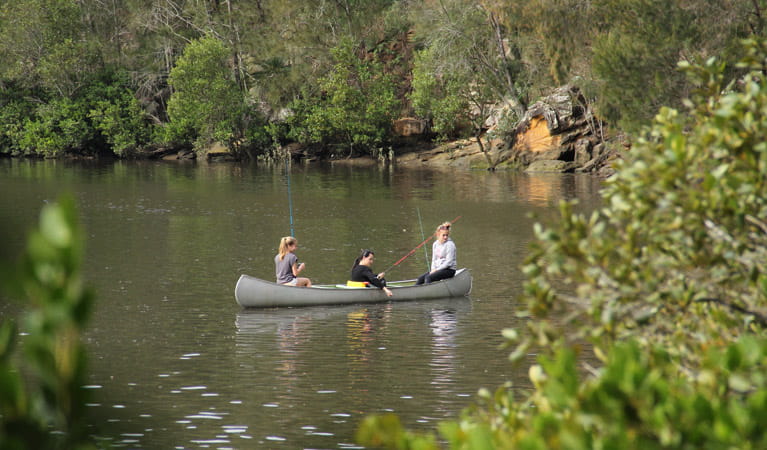Berowra Valley National Park
Join the Great North walk, mess about on a boat, have a barbecue or enjoy scenic views from one of the lookouts in Berowra Valley National Park, just north of Sydney.
Read more about Berowra Valley National Park
This large park occupies the beautiful bushland valley between the suburbs of Hornsby Heights, Thornleigh, Galston, Pennant Hills and Cherrybrook, reaching up to the quiet waters of Berowra Creek.
Covering a 25km stretch of the Great North walk, the park offers more than 70km of walking tracks and fire trails. If you’d rather enjoy nature at a slower pace, enjoy a picnic or barbecue at Crosslands Reserve, so close to the suburbs and yet so far from the speed of daily life. Berowra Creek is a great spot for some canoeing or kayaking, and there are some good places to dangle your line overboard - you might be lucky enough to catch some lunch.
Local alerts
For the latest updates on fires, closures and other alerts in this area, see https://www.nationalparks.nsw.gov.au/visit-a-park/parks/berowra-valley-national-park/local-alerts
Map
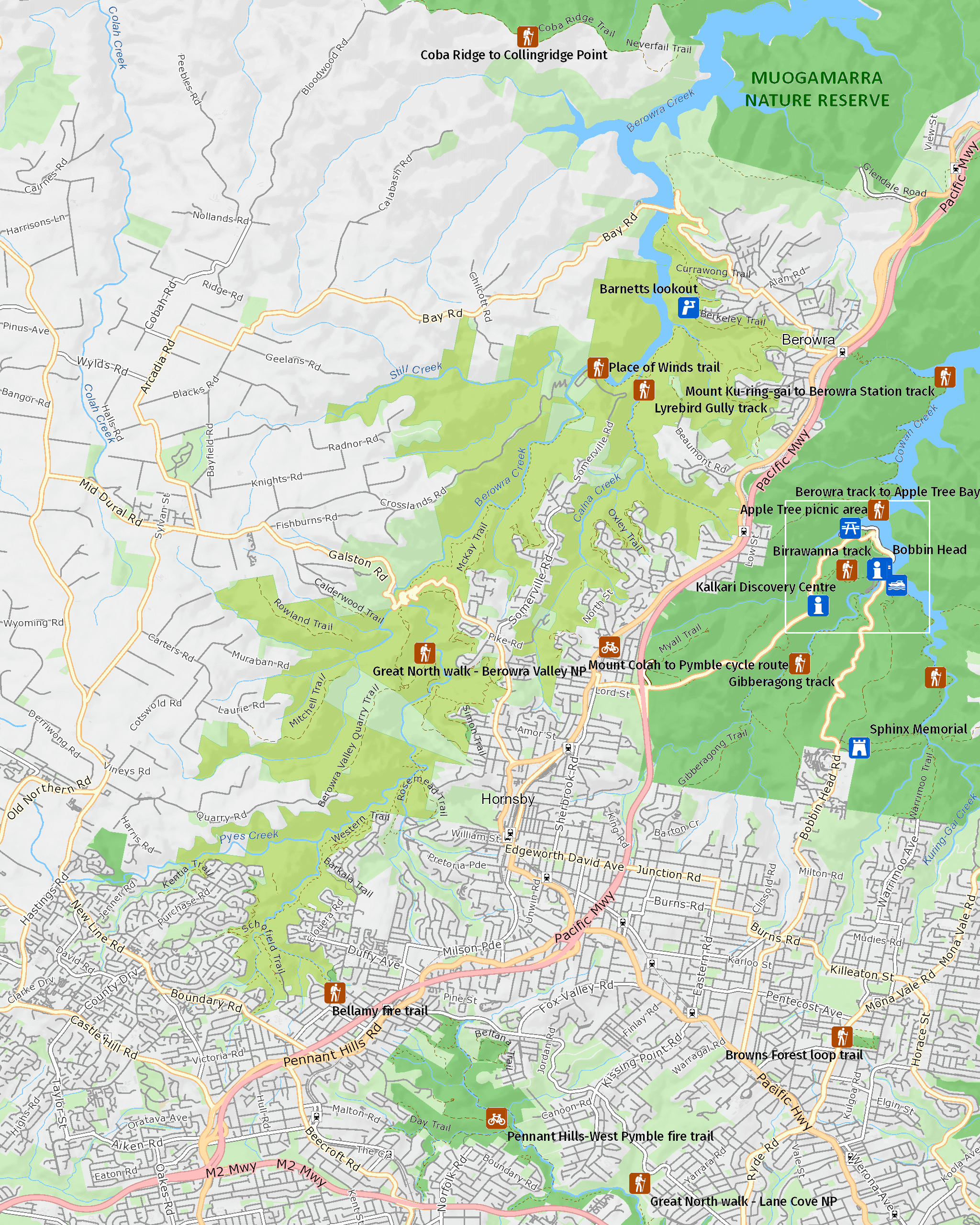
Map legend

Contact
- in the Sydney and surrounds region
- Berowra Valley National Park is always open but may have to close at times due to poor weather or fire danger
- Crosslands Reserve is open 8am to 7.30pm during daylight savings and 9am to 5pm the rest of the year
- Barnetts Road Reserve and the lookout is closed from sunset to sunrise
-
-
Bobbin Head Visitor Centre
02 9472 8949
Contact hours: 10am to 4pm daily. 9am to 4pm during summer school holidays, closed 12pm-12:30pm. Closed Christmas Day. - 688 Ku-ring-gai Chase Road, Mount Colah, NSW 2079
-
Email: bobbin.head@environment.nsw.gov.au
-
Bobbin Head Visitor Centre
Visitor info
All the practical information you need to know about Berowra Valley National Park.
Getting there and parking
Get driving directions
For the Great North walk, Benowie walking track and Jungo walk from the M2 motorway:
- Take the Pennant Hills Road exit and head north
- Turn left at Observatory Park to stay on Pennant Hills Road
- Turn left onto Boundary Road in Pennant Hills
- Turn right onto Bellamy Street and follow all the way to the end of the road, where the tracks begin
From Westleigh, Thornleigh, Hornsby and Galston Gorge:
- You can also join the Benowie walking track from Manor Road, Hornsby, Quarter Sessions Road, Westleigh, or the Galston Gorge on Galston Road and via the Bellamy fire trail off De Saxe Close, Thornleigh
From Hornsby to Crosslands Reserve:
- Take the Pacific Highway north from Hornsby
- Turn left onto Galston Road
- Turn right onto Somerville Road
- Follow the road through the gate to the carpark at the end of the road
From Hornsby to Barnetts lookout:
- Take the Pacific Highway north from Hornsby
- At Berowra Heights, turn left onto Berowra Waters Road
- Turn left onto Barnetts Road. The carpark is located at the end of Barnetts Road
By bike
Check out the Bicycle information for NSW website for more information.
Best times to visit
There are lots of great things waiting for you in Berowra Valley National Park. Here are some of the highlights.
Spring
Enjoy the spring wildflowers and take on the challenge of the Great North walk before the weather gets too warm
Summer
Swim in Berowra creek in the warmer months - remember safety precautions around waterways
Winter
Winter is generally great for bushwalking in the Sydney region but bring warm gear if youre camping - nights can be cold in the bush
Weather, temperature and rainfall
Summer temperature
Average
18°C and 28°C
Highest recorded
43.1°C
Winter temperature
Average
6°C and 18°C
Lowest recorded
-3.5°C
Rainfall
Wettest month
March
Driest month
July
The area’s highest recorded rainfall in one day
253mm
Maps and downloads
Prohibited
Horses
Pets
Pets and domestic animals (other than certified assistance animals) are not permitted. Find out which regional parks allow dog walking and see the pets in parks policy for more information.
Please note you can walk your dog on the section of Bellamy Fire trail* that traverses the adjacent Berowra Valley Regional Park.
Smoking
NSW national parks are no smoking areas.
Nearby towns
Hornsby (3 km)
A suburb in Sydney's upper north shore, Hornsby is conveniently located for easy access to Lane Cove National Park, Berowra Valley Regional Park, and the heritage-listed Ku-ring-gai Chase National Park - Australia's second-oldest national park. Explore walking and cycling tracks and Aboriginal sites, as well as marinas, cafes and picnic areas.
Parramatta (17 km)
Parramatta offers a fascinating insight into early colonial life in Australia. Don't miss a visit to Old Government House, now one of 11 Australian Convict Sites on the UNESCO World Heritage list.
Sydney City Centre (39 km)
No trip to Sydney is complete without spending some time in the city’s beautiful parks. Whether it’s in central areas like Hyde Park or the Royal Botanic Gardens or further out in Centennial Parklands, there’s plenty of green space to go out and enjoy.
Learn more
Berowra Valley National Park is a special place. Here are just some of the reasons why:
Wonderful waterways
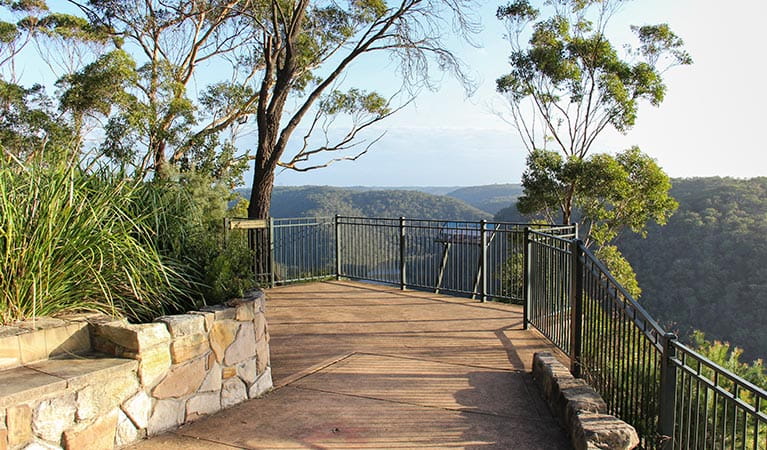
Berowra Creek is a hidden waterway perfect for canoeing, boating and fishing. Escape the noise and traffic of the city and come and while away a few hours in the perfect serenity of this lovely little spot. Load up your pack with sandwiches and hats and take the family for a wander along the trails or laze under a tree at Crosslands Reserve while the kids play.
Making tracks
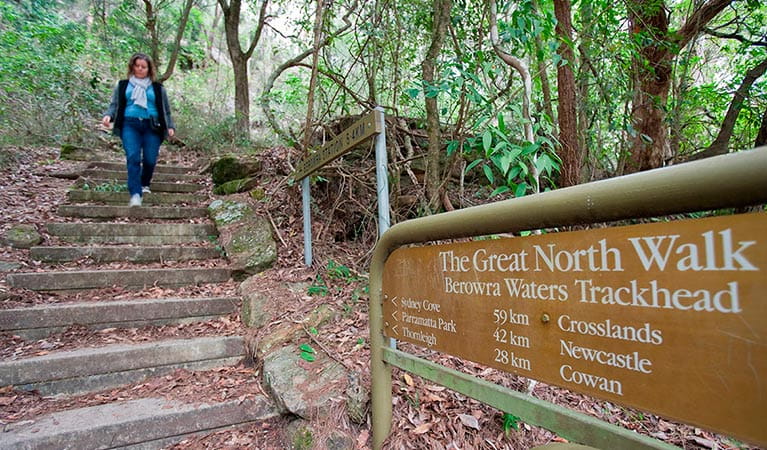
Great North walk is an iconic track that stretches 250km from Sydney to Newcastle. Constructed in 1988 as part of the Australian Bicentenary, the walk takes in diverse landscapes and a lot of Australian history. Part of the walk travels through Berowra Valley National Park along the Benowie walking track.
- Great North walk stage 3: Across the watershed Join this guided tour in Berowra Valley National Park. You'll walk 10km across Sydney’s north from Thornleigh to Hornsby. This walk is the 3rd stage in the series of Great North walks.
- Great North walk stage 4: Into the gorge On this 16km hike we'll traverse Galston Gorge, beautiful waterholes, and wonderful rock overhangs in Berowra Valley National Park. Start and end the day at Hornsby station. Sign up now and challenge yourself on stage 4 of the Great North walk.
- Great North walk stage 5: Hidden valleys part 1 Stage 5 of the Great North walk takes us from Hornsby to Berowra stations. Explore 12km on this guided walk through the hidden valleys of Berowra Valley National Park.
- Great North walk stage 6: Hidden valleys part 2 Take in stunning views of Berowra Valley National Park on stage 6 of the Great North walk. You’ll explore 14km of bushland between Berowra and Cowan stations on this 8-hour guided tour.
Bush in the 'burbs
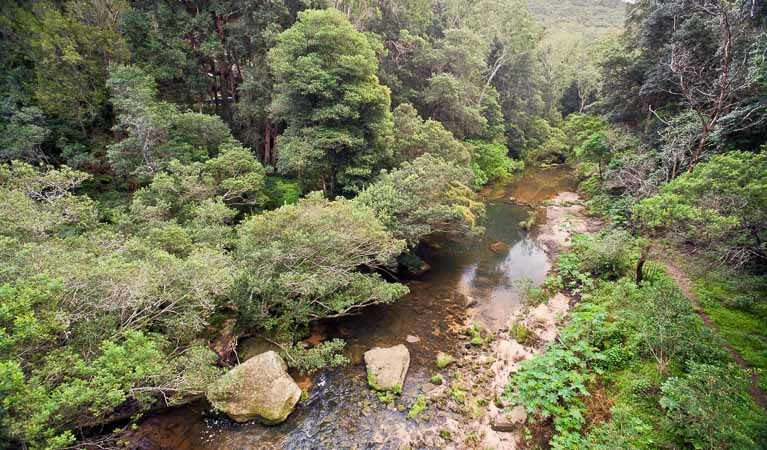
Eucalypt forests, delightful birdlife and all manner of creatures occupy this very beautiful bush valley stretching from the suburbs out towards the Hawkesbury river. While you're in the park, keep your eye out for a powerful owl, sea eagle, wedgetail, or listen for the call of a red crown toadlet.
Aboriginal importance
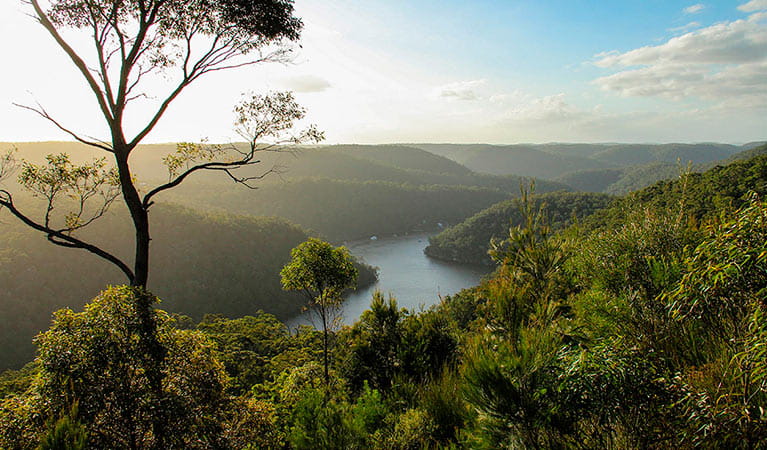
Berowra Valley National Park is within the traditional Country of the Guringai People to the east of Berowra Creek and the Dharug People to the west. It contains a number of significant Aboriginal heritage sites, including artefacts, middens and campfire sites. This special area, with its land and waterways, plants and animals, features in all facets of Aboriginal culture and continues to be of great significance to Aboriginal people today.
Plants and animals protected in this park
Animals
-
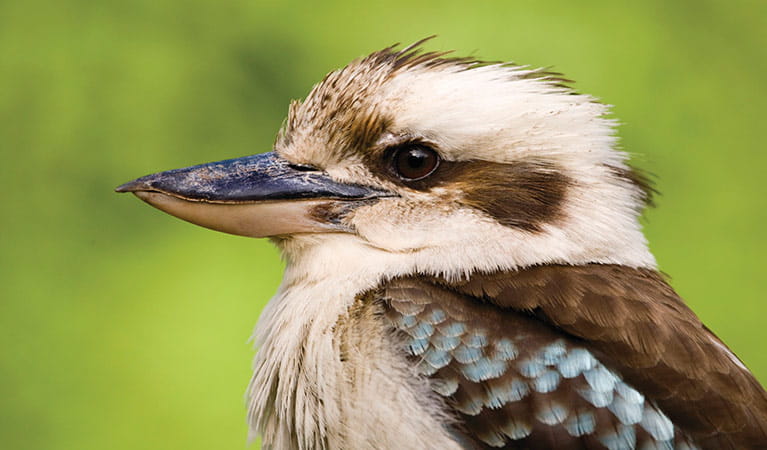
Kookaburra (Dacelo novaeguineae)
Of the 2 species of kookaburra found in Australia, the laughing kookaburra is the best-known and the largest of the native kingfishers. With its distinctive riotous call, the laughing kookaburra is commonly heard in open woodlands and forests throughout NSW national parks, making these ideal spots for bird watching.
-

Superb lyrebird (Menura novaehollandiae)
With a complex mimicking call and an elaborate courtship dance to match, the superb lyrebird is one of the most spectacular Australian animals. A bird watching must-see, the superb lyrebird can be found in rainforests and wet woodlands across eastern NSW and Victoria.
-

Swamp wallaby (Wallabia bicolor)
The swamp wallaby, also known as the black wallaby or black pademelon, lives in the dense understorey of rainforests, woodlands and dry sclerophyll forest along eastern Australia. This unique Australian macropod has a dark black-grey coat with a distinctive light-coloured cheek stripe.
Plants
-
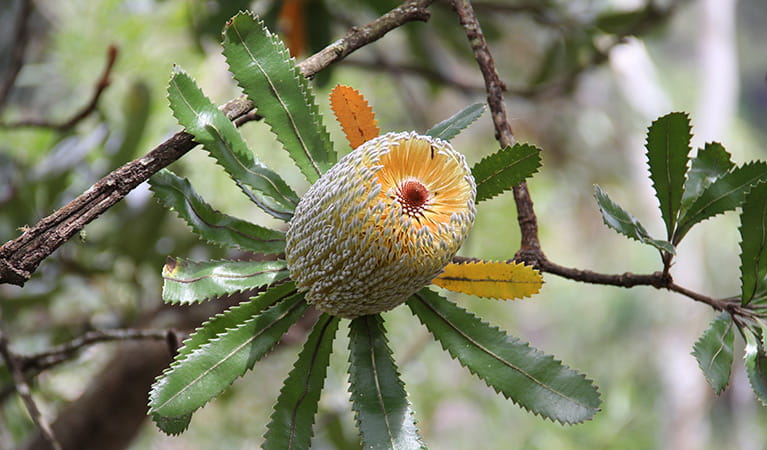
Old man banksia (Banksia serrata)
Hardy Australian native plants, old man banksias can be found along the coast, and in the dry sclerophyll forests and sandstone mountain ranges of NSW. With roughened bark and gnarled limbs, they produce a distinctive cylindrical yellow-green banksia flower which blossoms from summer to early autumn.
Environments in this park
Education resources (1)
What we're doing
Berowra Valley National Park has management strategies in place to protect and conserve the values of this park. Visit the OEH website for detailed park and fire management documents. Here is just some of the work we’re doing to conserve these values:
Preserving biodiversity
Berowra Valley National Park upholds its biodiversity by protecting endangered species. Conservation activities are habitually carried out in this park, and can include surveys and data collection on species distribution and population.
Managing weeds, pest animals and other threats
Pests and weeds have a significant impact to the ecosystems within Berowra Valley National Park. Risk assessments for new and emerging weeds are carried out as an ongoing initiative within the park. Pest management is an important part of the work NPWS does to protect the integrity of biodiversity which exists within Berowra Valley.
Developing visitor facilities and experiences
Berowra Valley National Park works to keep its visitors safe and informed, and this extends to issues of signage. Displaying up to date, easily understandable signage is an ongoing priority in this park. The park’s status is reflected in clearly displayed signage along with entry points.
Conserving our Aboriginal culture
Berowra Valley National Park is the traditional country of the Dharug People. Containing numerous significant Aboriginal sites, including artworks, artefacts, middens and campfire areas, it features many facets of Aboriginal culture. There are ongoing projects to monitor these sites, and NPWS supports tourism initiatives of the local Aboriginal community to preserve the values of Berowra Valley National Park for future generations.
Managing fire
NSW is one of the most bushfire prone areas in the world as a result of our climate, weather systems, vegetation and the rugged terrain. NPWS is committed to maintaining natural and cultural heritage values and minimising the likelihood and impact of bushfires via a strategic program of fire research, fire planning, hazard reduction, highly trained rapid response firefighting crews and community alerts.
General enquiries
- National Parks Contact Centre
- 7am to 7pm daily
- 1300 072 757 (13000 PARKS) for the cost of a local call within Australia excluding mobiles
- parks.info@environment.nsw.gov.au
Contact
- in the Sydney and surrounds region
- Berowra Valley National Park is always open but may have to close at times due to poor weather or fire danger
- Crosslands Reserve is open 8am to 7.30pm during daylight savings and 9am to 5pm the rest of the year
- Barnetts Road Reserve and the lookout is closed from sunset to sunrise
-
-
Bobbin Head Visitor Centre
02 9472 8949
Contact hours: 10am to 4pm daily. 9am to 4pm during summer school holidays, closed 12pm-12:30pm. Closed Christmas Day. - 688 Ku-ring-gai Chase Road, Mount Colah, NSW 2079
-
Email: bobbin.head@environment.nsw.gov.au
-
Bobbin Head Visitor Centre

